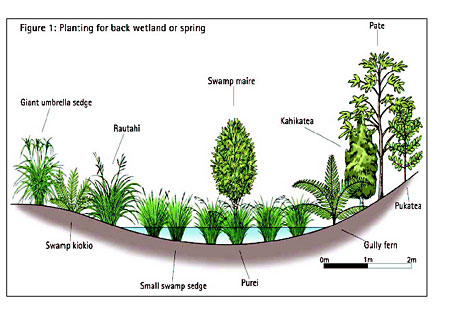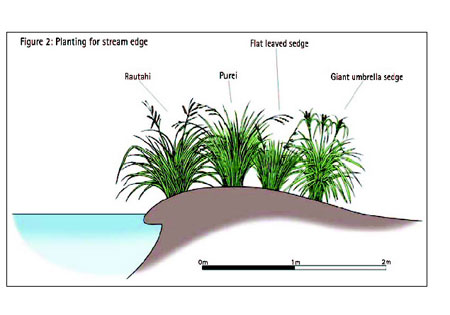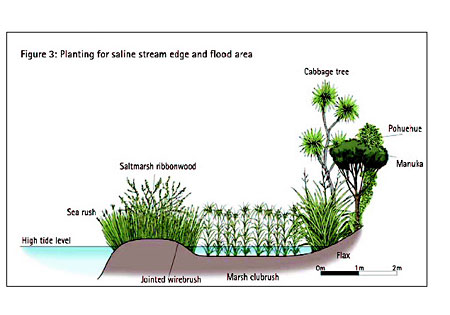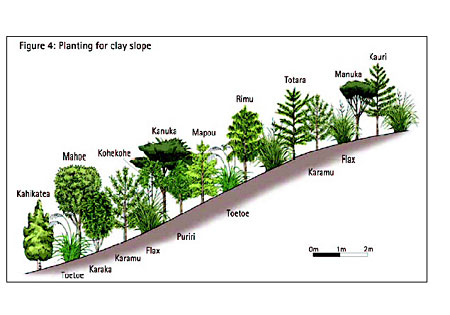Plans, policies and reports
District Plan Hauraki Gulf Islands Section - Proposed 2006
(Notified version 2006)
Street index |
Planning maps |
Text |
Appendices |
Annexures |
Section 32 material |
Plan modifications |
Help |
Notified - Home |
Decision - Home
Appendix 13 - Planting guides
Introduction
Table 1: Planting guide
Figure 1: Planting for back wetland or spring
Figure 2: Planting for stream edge
Figure 3: Planting for saline stream edge and flood area
Figure 4: Planting for clay slope
Introduction
The table in this appendix identifies suitable indigenous
species for planting in the following situations:
- locations where fire resistant plants
are required
- effluent disposal fields
- erosion control and bank stabilisation
- coastal margins
- stream margins
- wetlands.
The figures following the table show how different plant
species can be grouped in particular situations.
Note: Users of this guide are encouraged to refer to
the following publications and websites for detailed guidance on planting.
The Landcare Research plant species selector is highly recommended.
References
Auckland Regional Council, Wonderful Wetlands - Wetland
Restoration and Planting Guide for the Auckland Region, Factsheet available
at www.arc.govt.nz
Chapple, Don, Rachel Ebbett and Ivan Kitson, Greening
our Gulf Islands - A manual for native revegetation with special reference
to Waiheke, May 2000.
Auckland Regional Council, Riparian Zone Management
- Planting Guide, www.arc.govt.nz
Auckland Regional Council, TP58 Technical Sheet G-1,
Plants suitable for on-site wastewater disposal systems
Manaaki Whenua Landcare Research, Plant species selector,
http://www.landcareresearch.co.nz/research/biodiversity/greentoolbox
Table 1: Planting guide
| Maori
name |
Common
name
|
Scientific
name |
Resists
fire |
Suitable
for effluent disposal fields |
Suitable
for general erosion control and bank stabilisation |
Suitable
for coastal, saltmarsh saline stream margins and flood areas |
Suitable
for wetlands / swamps and stream margins |
| Akiraho |
|
Olearia paniculata |
|
|
|
Yes |
wind and salt spray tolerant |
|
|
|
|
| Hangehange |
|
Geniostoma liqustrifolium |
Yes |
Yes |
moist drained |
|
|
|
|
|
|
| Harekeke
|
Flax |
Phormium tenax |
|
Yes |
very wet |
|
|
Yes |
above flood line |
Yes |
moist edges / swampy areas |
| Hukihuki |
Swamp coprosma |
Coprosma tenuicaulis |
|
Yes |
very wet |
|
|
|
|
Yes |
swampy areas
|
| Kahikatea * |
White pine |
Dacrycarpus dacrydioides |
|
Yes |
moist / wet site |
Yes |
clay slope planting |
|
|
Yes |
moist edges / flood plains |
| Kaikomako |
|
Penantia corymbosa |
|
Yes |
moist |
|
|
|
|
Yes |
moist fertile |
| Kamahi * |
|
Weinmannia racemosa |
|
Yes |
wet |
|
|
|
|
|
|
| Kanono |
|
Coprosma grandifolia |
Yes |
|
|
|
|
|
|
|
|
| Kanuka * |
Tea tree |
Kunzea ericoides |
|
|
|
Yes |
slip face stabilisation |
|
|
|
|
| Kapungawha |
Clubrush |
Schoenoplectus tabernaemontanii |
|
|
|
|
|
Yes |
coastal streams / salty water |
Yes |
standing water and salt water |
| Karaka |
|
Corynocarpus laevigatus |
Yes |
|
|
|
|
|
|
|
|
| Karamu * |
Looking glass plant |
Coprosma robusta, C. lucida |
Yes |
Yes |
wet |
Yes |
clay slope planting |
|
|
Yes |
moist edges |
| Karo * |
|
Pittosporum crassifolium |
Yes |
|
|
Yes |
wind and salt spray tolerant |
|
|
|
|
| Kauri * |
|
Agathis australis |
|
|
|
Yes |
clay slope planting |
|
|
|
|
| Kawakawa * |
|
Macropiper excelsum |
Yes |
|
|
|
|
|
|
Yes |
moist edges
|
| Kio kio |
Swamp kiokio (fern) |
Blechnum novae-zealandiae |
|
Yes |
moist |
|
|
|
|
Yes |
swamp |
| Kohekohe * |
|
Dyoxylum spectabile |
|
|
|
Yes |
clay slope planting |
|
|
|
|
| Koromiko |
|
Hebe stricta var. strict |
|
Yes |
moist drained |
|
|
|
|
Yes |
moist edges |
| Kotukutuku |
|
Fuchsia excorticata |
Yes |
|
|
|
|
|
|
|
|
| Kowhai * |
|
Sophora microphylla |
|
Yes |
wet |
|
|
Yes |
lower saline slopes |
Yes |
moist edges |
| Kukaraho |
Marsh club rush |
Bolboschoenus fluviatilis |
|
|
|
|
|
Yes |
coastal stream margins / salt |
Yes |
standing water |
| Kumerahou * |
Golden tainui |
Pomaderris kumerahou |
|
|
|
Yes |
slip face stabilisation
|
|
|
|
|
| Kuta kuta |
Bamboo spike sedge |
Eleocharis spahacelata |
|
|
|
|
|
|
|
Yes |
standing water / swamp /edges |
| Maakaka |
Swamp ribbonwood |
Plagianthus divaricatus |
|
|
|
|
|
|
|
Yes |
wetland plant |
| Maakoako |
Sea primrose |
Samolus repens |
|
|
|
|
|
Yes |
salt marsh banks and & cliffs |
|
|
| Mahoe * |
Whitey wood |
Melicytus ramiflorus |
|
Yes |
wet |
Yes |
roots stabilise banks |
|
|
Yes |
moist edges |
| Maire-tawaki * |
Swamp maire |
Syzygium maire |
|
Yes |
very wet |
|
|
|
|
Yes |
wetland and margin |
| Makaka * |
Shore ribbonwood |
Plagianthus betunlinus |
|
|
|
|
|
Yes |
very salty conditions |
Yes |
wetland and margins |
| Makomako * |
Wineberry |
Aristotelia serrata |
|
Yes |
wet |
|
|
|
|
Yes |
wetland and margins |
| Manihi |
Red pondweed |
Potomogeton cheesmanii |
|
|
|
|
|
|
|
Yes |
standing water to 4m deep |
| Manuka * |
Red teatree |
Leptospernum scoparium |
|
Yes |
very wet |
Yes |
clay slope planting |
Yes |
lower saline slopes |
Yes |
wetland and moist edges |
| Mingimingi * |
|
Coprosma propinqua |
|
Yes |
wet |
|
|
|
|
Yes |
wetland and margins |
| Miro * |
Brown pine |
Prumnopitys ferruginea |
|
|
|
|
|
|
|
|
|
| Ngaio * |
|
Myoporum laetum |
|
|
|
Yes |
erosion control |
|
|
|
|
| Nikau * |
|
Rhopalostylis sapida |
|
Yes |
wet/shade |
|
|
|
|
Yes |
moist edges / wind sensitive |
| Oioi |
Sea rush |
Juncus maritimus |
|
|
|
|
|
Yes |
saltmarsh and estuaries |
|
|
| Papauma |
|
Griselinia littoralis |
Yes |
|
|
|
|
|
|
|
|
| Parataniwha |
|
Elatostema rugosum |
|
Yes |
moist |
|
|
|
|
Yes |
moist edges |
| Pate * |
|
Schefflera digitata |
|
Yes |
wet |
|
|
|
|
Yes |
moist edges |
| Pohuehue * |
Wirevine |
Muehlenbeckia complexa |
|
|
|
Yes |
binding plant - dune |
Yes |
lower saline slopes |
|
|
| Pohutukawa * |
|
Metrosideros excelsa |
|
|
|
Yes |
bank stabilising |
Yes |
lower saline slopes |
|
|
| Poroporo |
|
Solanum aviculare |
Yes |
|
|
|
|
|
|
|
|
| Puka * |
|
Griselinia lucida |
Yes |
|
|
Yes |
clay slope planting
|
|
|
|
|
| Pukatea * |
|
Laurelia novae-zelandiae |
|
Yes |
very wet |
|
|
|
|
Yes |
swamp/floodplain/edges |
| Purei |
Rush |
Carex secta, C. virgata |
|
|
|
Yes |
foliage protects soil surface |
|
|
Yes |
standing water / swampy areas |
| Puriri * |
|
Vitex lucens |
|
Yes |
moist drained |
|
|
|
|
Yes |
moist edges well drained |
| Putaputaweta |
Marbleleaf |
carpodetus serratus |
Yes |
Yes |
very wet |
|
|
|
|
Yes |
swampy areas /moist margins |
| Raupo |
|
Typha orientalis |
|
|
|
|
|
|
|
Yes |
standing water to 1m / swamp |
| Raurekau |
|
Coprosma australis |
Yes |
|
|
|
|
|
|
|
|
| Rautahi |
|
Carex lessoniana, C. geminata |
|
Yes |
very wet |
|
|
|
|
Yes |
lowland swamps |
| Remuremu |
|
Selliera radicans |
|
|
|
|
|
Yes |
salt marshes / dune hollows |
|
|
| Rimu * |
|
Dacrydium cupressinum |
|
|
|
Yes |
clay slope planting |
|
|
|
|
| Tauhinu * |
Golden cottonwood |
Cassinia fulvida |
|
Yes |
very wet |
|
|
|
|
Yes |
standing water |
| Taupata * |
|
Coprosma repens |
Yes |
|
|
Yes |
exposed coastal sites |
|
|
|
|
| Ti koura * |
Cabbage tree |
Cordyline australis |
|
Yes |
very wet |
|
|
Yes |
lower saline slopes |
Yes |
moist edges and swamp |
| Toetoe * |
|
Cyperus ustulatus |
|
Yes |
wet |
Yes |
foliage protects soil surface |
|
|
Yes |
shallow water and edges |
| Totara * |
|
Podocarpus totara |
|
|
|
Yes |
soil stabilising deep root |
|
|
|
|
| Tupari maunga |
Tussock sedge |
Gahnia xanthocarpa |
|
|
|
|
|
|
|
Yes |
swampy areas |
| Ureure |
|
Sarcocornia quinqueflora |
|
|
|
|
|
Yes |
salt marshes and salt meadows |
|
|
| Waewae kotuku |
Tangle fern |
Gleichenia dicarpa |
|
|
|
|
|
|
|
Yes |
damp wetlands
|
| Whekiponga |
Swamp tree fern |
Dicksonia squarrosa |
|
Yes |
moist |
|
|
|
|
Yes |
moist margins |
| Wiiwii |
Rushes |
Juncus gregiflorus, J. sarophorus |
|
|
|
|
|
|
|
Yes |
swampy areas |
| Wiwi |
|
Leptocarpus similis |
|
|
|
|
|
Yes |
saline stream edge |
|
|
| |
Five finger |
Pseudopanax arboreus |
Yes |
|
|
|
|
|
|
|
|
| |
Flat leaved sedge |
Carrex dissata |
|
|
|
Yes |
foliage protects soil surface |
|
|
Yes |
stream banks |
| |
Salt marsh ribbonwood |
Plagianthus divircatus |
|
|
|
|
|
Yes |
lowest saline edges |
|
|
| |
Veined coprosma |
Coprosma areolata |
|
Yes |
moist |
|
|
|
|
Yes |
moist edges |
| |
Wetland sedge |
Carex virgata |
|
|
|
Yes |
foliage protects soil surface |
|
|
Yes |
standing water / moist edges |
| |
Wetland sedge |
Carex dissita |
|
|
|
|
|
|
|
Yes |
standing water / moist edges |
| |
|
Hypolepis dicksonioides |
|
Yes |
moist drained |
|
|
|
|
Yes |
moist edges |
Yes indicates the most suitable
plant for circumstances.
* indicates the plant appears in the publication Greening
our Gulf Islands - see references.
Figure 1: Planting for back wetland or spring

Figure 2: Planting for stream edge

Figure 3: Planting for saline stream edge and flood area

Figure 4: Planting for clay slope

Images from Auckland Regional Council, Riparian Zone
Management - Planting Guide.

